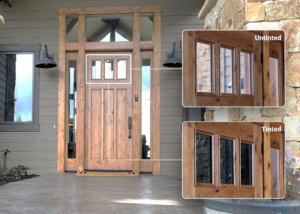Housing
July 5, 2023—The idea of dimming your living room windows from an app may seem futuristic, but it has roots in the late 1980s. Electronically dimmable glass was invented over 30 years ago and has since gone into millions of car rear and side-view mirrors and thousands of Boeing and Airbus passenger plane windows. The leading manufacturers in this space sell approximately 50 million products annually.
Dimmable glass technology used in auto and aerospace industry products is based on electrochromic dyes, but this technology was historically not durable to ultraviolet (UV) light from the sun’s rays. Glass Dyenamics co-founders Anoop Agrawal and John Cronin were co-inventors of the earliest dimmable glass technologies and eventually overcame the UV-durability hurdle. They then joined their vision with fellow co-founder and CEO Christopher Angelo to create Glass Dyenamics.
“The material includes dyes inside the glass,” Angelo said. “When you apply a voltage to a sensor in the window, the glass tints automatically and on demand. This could be the next solar panel.”
According to Angelo, dimmable glass helps improve building energy efficiency by modulating the amount of solar heat entering a building. In the summer, the glass can tint, which reduces the amount of heat entering, and in the winter, the glass can un-tint, which allows more solar heat to enter. This energy modulation results in savings—DOE and industry studies suggest that this type of glass can save homeowners up to 20% on utility bills.
While residential solar only accounts for 2% of the residential housing market, and projected growth is slow, energy-efficient glass has a 90% cumulative market share, which Angelo describes as a “proven indicator of climate impact and market adoption.”
“It’s an unknown clean technology success story,” Angelo said. “We want to capitalize on that.”
Glass Dyenamics believes its technology is a better value proposition than the traditional residential solar module since it costs less and is independent from the utility network.
“It’s also cool,” Angelo said. “When you see the glass tint, you say, ‘This is different. This is really neat.’ You can control it with your phone while sitting on a couch. It’s like a cool party trick. It’s something you want to show off to your friends.”

Dimmable glass helps improve building energy efficiency by modulating the amount of solar heat entering a building—DOE and industry studies suggest that this type of glass can save homeowners up to 20% on utility bills. Photo courtesy of Glass Dyenamics
Glass Dyenamics creates their product by inserting a proprietary electrolyte with dyes between two pieces of conductive glass and then sends it to door and window manufacturers or distributors. The glass also provides an advanced user experience, where users can control the glass tint level through a mobile phone app. The company has its first installation in a home in Bend, Oregon, and is working on commercialization and scaling. The company also demonstrated a larger product with what it claims is an industry-leading tint-time with an immediate visual response.
Angelo said they expect to start with additional installations in Arizona, the company’s location, Oregon, San Francisco, and Los Angeles.
Glass Dyenamics joined the Wells Fargo Innovation Incubator (IN2) program in 2017 to test the glass’s durability to prove the core advanced material’s feasibility. A follow-on program from the Department of Energy helped them to further improve durability and commercial readiness. A more recent program with the National Renewable Energy Laboratory (NREL) showed the company’s potential to develop different color dyes without changing the manufacturing process which may allow manufacturing at a low cost.
“The key technical obstacle for any new advanced glass like this is the environmental durability hurdle. IN2 was crucial for us to utilize NREL’s test chambers to validate our glass’ durability,” Angelo said.
Additionally, Glass Dyenamics keeps an eye on socioeconomic equity while developing its product.
“Our vision is for everyone to be part of the clean energy transition,” Angelo said. “When you consider the extremely high adoption rate of energy-efficient glass, and that our product can provide a similar customer value proposition to residential solar while costing ten times less and is independent of the utility network, we feel pretty good about our vision and where we’re going.”
The company got a major boost with homeowners when Congress included the technology in the Inflation Reduction Act (IRA). Over the next two years, there is up to a 50% investment tax credit for installing windows and doors with dimmable technology.
The math breaks down to this: A basic package to replace a home’s windows is around $55,000. Without the subsidies, windows with Glass Dyenamics’ product would cost around $73,000. However, with the IRA, it is 35% less expensive than the basic package, or about $36,000. Whether subsidies are ultimately available, the company sees a new way for everyone to participate in the clean energy transition.
